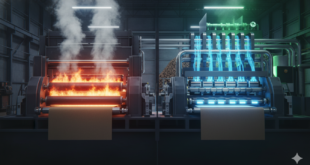Introduction:
The automotive industry is at a crossroads, with the buzz around electric vehicles (EVs) dominating headlines. However, experts specializing in emission and alternative fuel technologies are proposing a compelling case for the continued relevance of internal combustion engines (ICE). New engineering breakthroughs and progressive fuel policies are paving the way for ICE to play a crucial role in the future of clean transportation. This article delves into the promising developments that could extend the longevity of ICE technology, providing a nuanced perspective on the ongoing narrative of electric versus internal combustion.
The Renaissance of Internal Combustion:
While electric vehicles have rightfully claimed the spotlight, proponents of ICE technology argue that it still has untapped potential. The convergence of new energy sources and technological advancements is shaping a roadmap for ICE’s continued evolution. Biodiesel blends, natural gas, and hydrogen are emerging as key players in revitalizing the internal combustion engine, challenging the notion that it has reached the end of its innovation journey.
HCCI Combustion: The Clean-Burning Future of ICE
One of the most exciting breakthroughs is Homogeneous Charge Compression Ignition (HCCI) combustion. Unlike traditional gasoline engines that rely on spark plugs, HCCI engines precisely control the fuel and air mixture to ignite spontaneously under high pressure. This results in cleaner burning, lower emissions, and improved fuel efficiency compared to conventional ICEs.
Synthetic Fuels: Powering the Transition to Carbon Neutrality
Another game-changer is the development of synthetic fuels. These fuels are produced from captured carbon dioxide and renewable energy, essentially creating a closed-loop system that can be carbon-neutral. This means existing ICE vehicles can be powered by sustainable fuels, reducing their environmental impact without requiring widespread infrastructure changes.
Ethanol is emerging as a significant player in the passenger vehicle segment, with Maruti Suzuki set to launch E20 vehicles from April 2025. Ethanol, blended with petrol, is expected to play a key role in reducing carbon emissions. Additionally, the industry is exploring the potential of Compressed Biogas (CBG), which, if sourced from manure, could have a carbon-negative impact. These developments signal a multi-pathway approach to green mobility, aligning with the industry’s preparation for the EV journey, with several new models slated for release starting in 2025.
Biodiesel Blends: A Greener Liquid Fuel:
One avenue that holds promise for ICE technology is the integration of biodiesel blends. Derived from renewable resources such as vegetable oils and animal fats, biodiesel significantly reduces carbon emissions compared to traditional diesel. The compatibility of biodiesel with existing infrastructure and engines makes it a practical and eco-friendly choice, offering a cleaner alternative for those unwilling or unable to transition to full electric.
Natural Gas: Fueling the Future:
Natural gas is gaining traction as a transitional fuel that can bridge the gap between traditional fossil fuels and a fully electrified automotive landscape. Compressed natural gas (CNG) and liquefied natural gas (LNG) have the potential to reduce greenhouse gas emissions and enhance fuel efficiency. As infrastructure for natural gas expands, it presents a viable option for consumers and fleet operators looking for a cleaner alternative without sacrificing the convenience of traditional refueling methods.
Bio-CNG and Bio-LNG: Taking Natural Gas Even Greener
The development of bio-CNG and bio-LNG produced from renewable sources like biogas is further improving the environmental credentials of natural gas. This makes it an even more attractive option for those seeking to reduce their carbon footprint while leveraging the existing natural gas infrastructure.
Hydrogen: The Game-Changer for ICE:
Hydrogen is emerging as a game-changer in the quest to redefine ICE technology. Hydrogen-powered internal combustion engines offer zero-emission potential, as the only byproduct of combustion is water vapor. With advancements in hydrogen production and storage, this fuel source could become a transformative force in extending the lifespan of ICE vehicles. The adaptability of hydrogen engines to existing infrastructure adds to its appeal, potentially reshaping the future landscape of clean transportation.
Cummins, a global engine major, is investing in both electrified and ICE solutions.
The company’s focus for ICE technology development revolves around biodiesel blends, natural gas, and hydrogen. The company has developed a fuel-agnostic engine platform designed for diesel, natural gas, and hydrogen, emphasizing a commitment to low and zero-emission propulsion technology solutions.
In the pursuit of carbon-neutral technologies, Cummins has embraced a three-pronged approach, particularly emphasizing natural gas and hydrogen for extending the longevity of ICE technology. Hydrogen, in particular, is seen as crucial for the commercial vehicle industry’s transition away from diesel. As the government in India emphasizes the adoption of natural gas in the transportation sector, the industry is exploring various options such as CNG for urban areas, CBG for rural areas, and LNG for highways.
Challenges
While these advancements present a promising future for ICE, challenges remain. The characteristics of alternative fuels may necessitate engineering interventions, and government regulations and fiscal policies are crucial to facilitating the widespread adoption of biofuels. As engineers and researchers work on cleaner solutions for ICE, innovations may continue to reshape the landscape, reminiscent of Rudolf Diesel’s use of peanut oil to run a diesel engine in 1890. Overall, the developments in alternative fuels and cleaner solutions suggest a coexistence of electric and internal combustion technologies, providing consumers with a diverse range of sustainable choices for future mobility.
Conclusion:
As the automotive industry navigates the path to sustainability, the internal combustion engine is undergoing a renaissance, fueled by innovative engineering and forward-thinking fuel policies. Biodiesel blends, natural gas, synthetic fuels, and hydrogen are key players in this resurgence, challenging the prevailing narrative that electric vehicles are the sole future of transportation. The road ahead promises a diverse ecosystem where both electric and internal combustion technologies coexist, offering consumers a range of sustainable choices for the future of mobility.
Government policies and incentives will play a crucial role in accelerating the adoption of cleaner ICE technologies and fuels. Hybrid powertrains combining ICE with electric motors are also a promising option for optimal efficiency and performance. Ultimately, ICE has the potential to be a valuable contributor to a sustainable transportation future alongside electric vehicles, and the latest breakthroughs are paving the way for a cleaner and more efficient future for this technology.
By embracing these advancements and exploring new fuel options, the internal combustion engine can continue to play a vital role in powering our transportation needs for years to come.
 International Defense Security & Technology Your trusted Source for News, Research and Analysis
International Defense Security & Technology Your trusted Source for News, Research and Analysis




